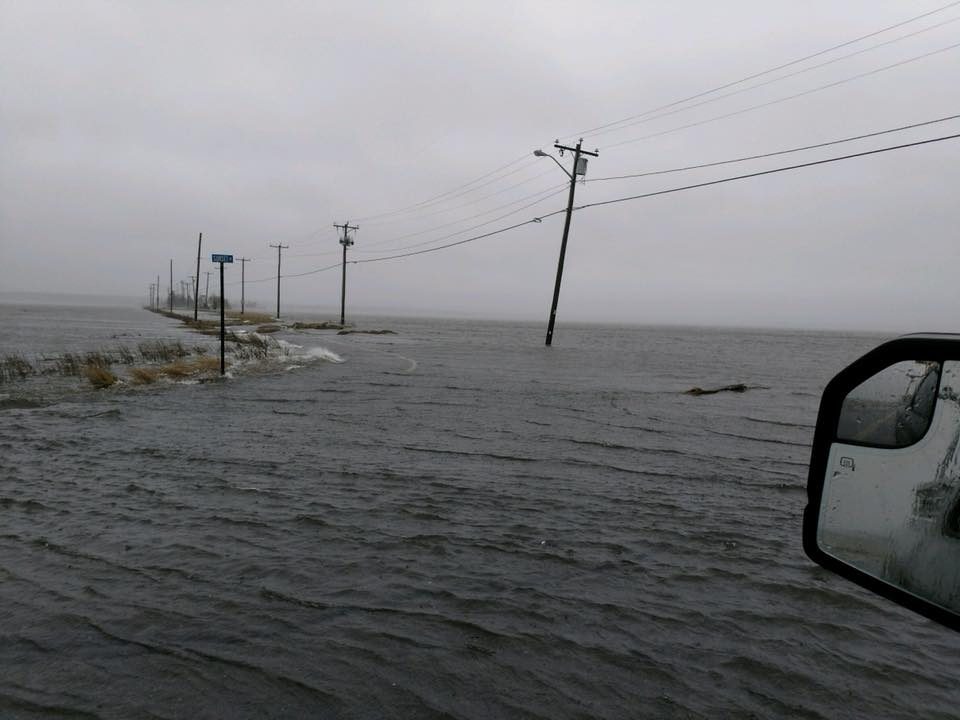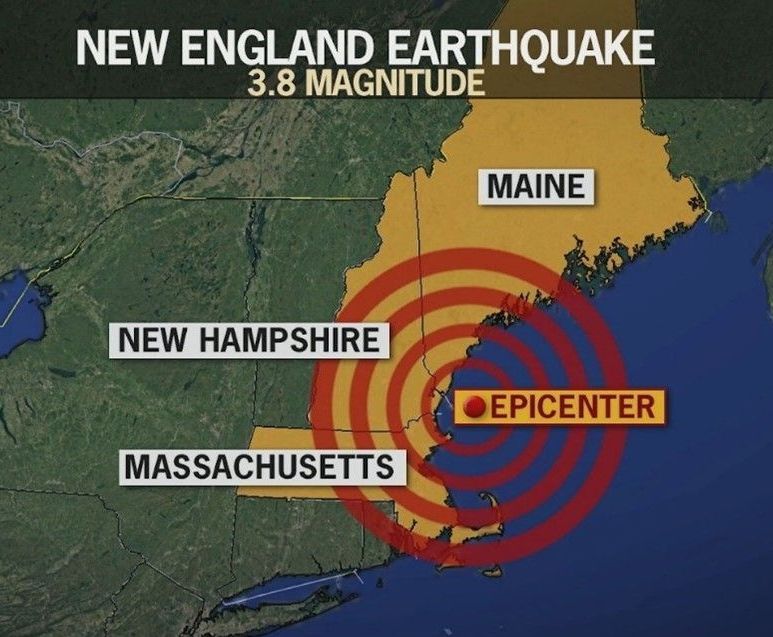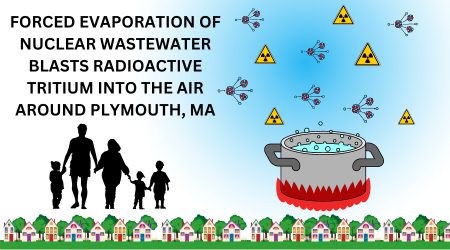Seabrook Under Water?
- By Samantha McCraine
- •
- 15 May, 2019
As one of the most vulnerable nuclear plants in the nation, policymakers and nuclear plant operators need to take the risks of climate change very seriously

In late April, the U.S. Nuclear Regulatory Commission (NRC) held its annual safety meeting about Seabrook Station (see related blog here). Because evacuation planning was on the agenda, it was not surprising that the topic of Seabrook’s vulnerability to the effects climate change was on people's minds.
Seabrook’s construction began in 1976, and although the plant was sited 20 feet above sea level and two miles inland, government projections show increasing risks for Seabrook and the surrounding coastal communities.
Current data from the National Oceanic and Atmospheric Administration (NOAA) shows how predicted sea level rise will reduce the planned buffer between Seabrook Station and the Atlantic Ocean (see map below). The Risk Finder tool provided by Climate Central shows that between 2016-2040, the risk of a flood of 5 feet or more (above the high tide line) is 54 percent in the Seabrook Beach area. By 2060, there is a 100 percent chance of such an event in the area. As sea waters rise, so does the high tide line, and risks of floods beyond current infrastructural capacity.
Similar risks were highlighted in the study “Underwater” released by the Union of Concerned Scientists (UCS) in 2018. Focusing on the impacts of sea level across the United States, their scientific data tells a story of chronic flooding along the eastern shore board. Area towns like Salisbury, Seabrook, Hampton and Newburyport will face frequent inundation as average sea levels rise. Along with private property, critical infrastructure across the nation such as roads, airports, power plants, and military bases will be constantly at risk of flooding and water damage.
Lessons from Fukushima
The 2011 disaster at the Fukushima-Daiichi power plant in Japan awoke the world to the dangers of nuclear power by the ocean. Although nuclear power plants are designed to need vast amounts of water for cooling, their location along coasts and rivers exposes them to risks of flooding, caused by rainfall, storms and tides.
After Fukushima, nuclear regulators and operators around the globe took an assessment of their risk exposure. In the U.S., the event prompted the Nuclear Regulatory Commission to undertake a study which revealed that 54 out of 60 nuclear power plants were not prepared to handle the flood risk they faced.
When Hurricane Sandy hit the Northeast U.S. in 2012, nuclear power plants in its path shut down as a preventative measure against water damage and power shortages like those which rocked Fukushima. In the superstorm’s aftermath, a Stanford University study surveyed the risks faced by coastal nuclear plants. The results revealed that Seabrook Station, located in coastal New Hampshire, is among the nation’s most vulnerable.
A recent article in Bloomberg Businessweek illustrated the connection between nuclear power plant safety risks identified by NRC operators in 2011 and the environmental risks to American communities identified in the UCS’s 2018 study. Their model shows that Seabrook Station faces the risk of an average of at least two floods a month by 2060.
How Sea Level Threatens Seabrook
The increased exposure to high sea levels at Seabrook Station pose at least four risks:
- Higher ground water levels surrounding the plant could exacerbate the problem of alkali-silica reaction (ASR) that is undermining the concrete in all key safety structures at the plant, including the core reactor dome and the spent fuel pool;
- High tides from increasingly severe storm surges create a risk of acute flooding, the kind which led to the Fukushima power shortage, and subsequent nuclear meltdown;
- Flooding in the event of such a storm could block low-lying evacuation routes that emergency planners depend upon to get people away from the area in the event of a serious radiological release; and finally,
- Once Seabrook Station enters its decommissioning phase, radioactive materials stored on site for “cooling,” remain vulnerable, and pose an ongoing risk to the surrounding ecosystem.
Despite these possibilities, the consideration of storm surges and flooding are conspicuously absent from plant owner NextEra Energy’s re-licensing documents. Despite mounting evidence of the risks posed by sea level rise along the northeastern coastline, the environmental report for renewal prepared by NextEra issues does little to address concerns such as flooding, sea level rise, storm surge or climate change.
Already, Seabrook and surrounding towns experience significant flood events with increasing frequency, particularly when Nor’easters hit. These are a test of preparedness and ability to manage risk.
The disaster at Fukushima was a result of natural hazards colliding with poor planning for structural resilience and safety. When flooding from the tsunami stopped the power supply which kept water pumping into the nuclear reactor’s core, the core overheated and proceeded to melt through its container, releasing radiation into the environment. Better planning for the unexpected could have saved countless lives and untold decades of environmental harm
Heads in the Sand?
Given the previous acknowledgement by the plant’s operators of the impending risks posed by climate change in the area, this indicates two serious points of concern: first, an apparent reluctance of the plant operators to consider all of the environmental hazards which might impair its ability to operate a high risk facility safely, and second, lack of regulatory attention to the potential for contamination of wetlands, groundwater, ocean water, and other risks posed by the potential for more frequent inundation awaiting Seabrook Station.
To address the potential threats posed by climate change, the NRC should require the types of measures recommended by NRC’s Near Term Task Force after the Fukushima accident, in order to ensure the safety of reactor communities, not weaken proposed regulations as the NRC commissioners did in January.
“This decision is nonsensical,” Commissioner Jeff Baran wrote in his dissent of the weak standards. “Instead of requiring nuclear power plants to be prepared for the actual flooding and earthquake hazards that could occur at their sites, NRC will allow them to be prepared only for the old, outdated hazards typically calculated decades ago when the science of seismology and hydrology was far less advanced than it is today,” he wrote.
Commissioner Stephen Burns added: “The accident at Fukushima was a direct result of the operator and regulator failing to take action to account for new scientific knowledge related to natural hazards, especially flooding hazards. . . . In the United States, there exists incontrovertible evidence that the current design bases for some plants do not address a flood hazard identified by the licensees’ [plant operators’] own analyses.”
Policy Leadership & Citizen Vigilance Needed
In addition to the type of federal leadership lacking under the current administration, policymakers at the local and state level must take their own steps to ensure that infrastructure development as well as evacuation plans include an assessment of climate change scenarios—especially of more severe and frequent storms and floods.
Federal regulations for nuclear plants need to catch up with the reality of climate change that is already upon us. In the absence of such vision and leadership, it falls to the vigilance of the citizens, and the work of state and local governments, to try to prepare and protect vulnerable communities and natural resources, as best they can.

Follow us



